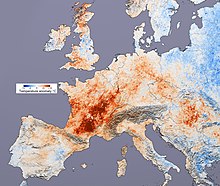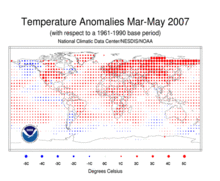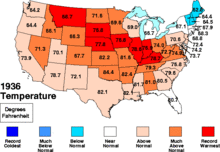Heat wave: Difference between revisions
m Heatwave Edits |
|||
| Line 109: | Line 109: | ||
The record for the longest heatwave in the world is generally accepted to have been set at [[Marble Bar]] in Australia, where from October 31, 1923 to April 07, 1924 the temperature broke the 37.8°C/100°F benchmark, setting the heat wave record at a scorching 160 days. |
The record for the longest heatwave in the world is generally accepted to have been set at [[Marble Bar]] in Australia, where from October 31, 1923 to April 07, 1924 the temperature broke the 37.8°C/100°F benchmark, setting the heat wave record at a scorching 160 days. |
||
==Heat Waves in the US== |
|||
New York City, Baltimore, Boston, Detroit, Chicago, Milwaukee, Dallas, Houston, Twin Cities, Cleveland, Cincinnati, etcetera, are vulnerable to severe heat waves and related fatalities caused in association. |
|||
==See also== |
==See also== |
||
Revision as of 21:47, 17 July 2008

A heat wave is a prolonged period of excessively hot weather, which may be accompanied by high humidity. There is no universal definition of a heat wave;[1] the term is relative to the usual weather in the area. Temperatures that people from a hotter climate consider normal can be termed a heat wave in a cooler area if they are outside the normal climate pattern for that area.[2] The term is applied both to routine weather variations and to extraordinary spells of heat which may occur only once a century. Severe heat waves have caused catastrophic crop failures, thousands of deaths from hyperthermia, and widespread power outages due to increased use of air conditioning.
Definitions

The definition recommended by the World Meteorological Organization is when the daily maximum temperature of more than five consecutive days exceeds the average maximum temperature by 5 °C (9 °F), the normal period being 1961 - 1990.[3]
A formal, peer-reviewed definition from the Glossary of Meteorology is:[4]
- A period of abnormally and uncomfortably hot and usually humid weather.
- To be a heat wave such a period should last at least one day, but conventionally it lasts from several days to several weeks. In 1900, A. T. Burrows more rigidly defined a “hot wave” as a spell of three or more days on each of which the maximum shade temperature reaches or exceeds 90 °F (32 °C). More realistically, the comfort criteria for any one region are dependent upon the normal conditions of that region.
A heat storm is an extended heat wave. Heat storms occur when the temperature reaches 100 °F (38 °C) for three or more consecutive days over a wide area (tens of thousands of square miles).
In the Netherlands, a heat wave is defined as period of at least 5 consecutive days in which the maximum temperature in De Bilt exceeds 25 °C (77 °F), provided that on at least 3 days in this period the maximum temperature in De Bilt exceeds 30 °C (86 °F).[3]. This definition of a heat wave is also used in Belgium, Denmark, and Luxembourg.
In the United States, definitions also vary by region; however, a heat wave is usually defined as a period of at least three consecutive days above 90 °F (32.2 °C).[4] The National Weather Service criterion for the issuance of a heat advisory is when the heat index is expected to (or does) reach 105 °F (40.6 °C) with a nighttime low temperature not below 80 °F (26.7 °C), whereas an excessive heat warning is issued when a maximum heat index exceeding 115 °F (46.1 °C) with minimum 80 °F (26.7 °C) is expected (or is occurring).
Incidence
Heat waves often occur during the Dog Days of summer; indeed the French term canicule, denoting the general phenomenon of a heat wave, derives from the Italian canicula applied to the star Sirius, also known as the "Dog Star."[5]
Some regions of the globe are more susceptible to heat waves than others, such as Mediterranean-type climates with a summer dry spell which becomes much hotter than usual during certain years.[citation needed]
How they occur
In the summer in warm climates, if there is an area of high pressure with little or no rain and clouds, there is nothing to protect the air and ground from being heated excessively. When large high pressure air is trapped, the ground and air will continue to heat and the heat wave will last longer.
The position of the jet stream is very important because the air on one side is hot while the other side is cold. Heat waves are far more likely and more severe when you are on the hot side. Sometimes the jet stream does not move far enough to make many areas that normally get hot on the hot side; but sometimes many cold areas are made hot abnormally. The effects of El Niño and La Niña (opposite reaction to El Niño) can severely disrupt the positions of the jet streams.

Large desert zones and dry areas are more likely to get extreme heat because there is rarely any high cloud cover with very low humidity, making it like a furnace.
The direction of the wind is a very important part of the reasons for heat waves, because this pushes hot air towards colder areas if they are going away from the deserts and equator. The higher the force of the wind as well as the distance they travel from the hotter to colder areas, generally means hotter weather.
Cities also get hotter because they generate heat from the use of power, usually by about 1-2 °C or so and experience very warm night time minimum temperatures putting further strain on energy demands.
Humidity also has a serious effect on how hot it feels but this does not make the actual temperature any hotter. Heat Waves in Eastern North America and North Western Europe are usually accompanied by high humidity, aggravating the heat index (one's discomfort), as opposed to the drier heat typically experienced during heat waves in continental Europe, Western North America or cities in Australia.
Perhaps the most well-known heat-related illness is hyperthermia, also known as heat stroke. Classic heat stroke occurs during periods of sustained high temperature and humidity. Sweating is absent from 84%-100% of those affected. Older adults, very young children, and those who are sick or overweight are at a higher risk for heat-related illness. The chronically ill and elderly are often taking prescription medications (e.g., diuretics, anticholinergics, antipsychotics, and antihypertensives) that interfere with the body's ability to dissipate heat.[6]
Heat edema presents as a transient swelling of the hands, feet, and ankles and is generally secondary to increased aldosterone secretion, which enhances water retention. When combined with peripheral vasodilation and venous stasis, the excess fluid accumulates in the dependent areas of the extremities. The heat edema usually resolves within several days after the patient becomes acclimated to the warmer environment. No treatment is required, although wearing support stocking and elevating the affected legs with help minimize the edema.
Heat rash, also known as prickly heat, is a maculopapular rash accompanied by acute inflammation and blocked sweat ducts. The sweat ducts may become dilated and may eventually rupture, producing small pruritic vesicles on an erythematous base. Heat rash affects areas of the body covered by tight clothing. If this continues for a duration of time it can lead to the development of chronic dermatitis or a secondary bacterial infection. Prevention is the best therapy. It is also advised to wear loose-fitting clothing in the heat. However, once heat rash has developed, the initial treatment involves the application of chlorhexidine lotion to remove any desquamated skin. The associated itching may be treated with topical or systemic antihistamines. If infection occurs a regimen of antibiotics is required.

Heat cramps are painful, often severe, involuntary spasms of the large muscle groups used in strenuous exercise. Heat cramps tend to occur after intense exertion. They usually develop in people performing heavy exercise while sweating profusely and replenishing fluid loss with non-electrolyte containing water. This is believed to lead to hyponatremia that induces cramping in stressed muscles. Rehydration with salt-containing fluids provides rapid relief. Patients with mild cramps can be given oral .2% salt solutions, while those with severe cramps require IV isotonic fluids. The many sport drinks on the market are a good source of electrolytes and are readily accessible.
Heat syncope is related to heat exposure that produces orthostatic hypotension. This hypotension can precipitate a near-syncopal episode. Heat syncope is believed to result from intense sweating, which leads to dehydration, followed by peripheral vasodilation and reduced venous blood return in the face of decreased vasomotor control. Management of heat syncope consists of cooling and rehydration of the patient using oral rehydration therapy (sport drinks) or isotonic IV fluids. People who experience heat syncope should avoid standing in the heat for long periods of time. They should move to a cooler environment and lie down if they recognize the initial symptoms. Wearing support stockings and engaging in deep knee-bending movements can help promote venous blood return.
Heat exhaustion is considered by experts to be the forerunner of heat stroke (hyperthermia). It may even resemble heat stroke, with the difference being that the neurologic function remains intact. Heat exhaustion is marked by excessive dehydration and electrolyte depletion. Symptoms may include headache, nausea, and vomiting, dizziness, tachycardia, malaise, and myalgia. Definitive therapy includes removing patients from the heat and replenishing their fluids. Most patients will require fluid replacement with IV isotonic fluids at first. The salt content is adjusted as necessary once the electrolyte levels are known. After discharge from the hospital, patients are instructed to rest, drink plenty of fluids for 2 - 3 hours, and avoid the heat for several days. If this advice is not followed it may then lead to heat stroke.
One public health measure taken during heat waves is the setting-up of air-conditioned public cooling centers.
Mortality

Heat waves are the most lethal type of weather phenomenon, overall. Between 1992 and 2001, deaths from excessive heat in the United States numbered 2,190, compared with 880 deaths from floods and 150 from hurricanes.[7] The average annual number of fatalities directly attributed to heat in the United States is about 400.[8] The 1995 Chicago heat wave, one of the worst in US history, led to approximately 600 heat-related deaths over a period of five days.[9] Eric Klinenberg, has noted that in the United States, the loss of human life in hot spells in summer exceeds that caused by all other weather events combined, including lightning, rain, floods, hurricanes, and tornadoes.[10][11]
Despite the dangers, Scott Sheridan, professor of geography at Kent State University, found that less than half of people 65 and older abide by heat-emergency recommendations like drinking lots of water. In his study of heat-wave behavior, focusing particularly on seniors in Philadelphia, Phoenix, Toronto, and Dayton, Ohio, he found that people over 65 "don't consider themselves seniors." "Heat doesn't bother me much, but I worry about my neighbors," said one of his older respondents.[12] According to the Agency for Healthcare Research and Quality, about 6,200 Americans are hospitalized each summer due to excessive heat, and those at highest risk are poor, uninsured or elderly.[13]
Underreporting and "Harvesting" effect
The number of heat fatalities is likely highly underreported due to lack of reports and misreports.[8] Part of the mortality observed during a heat wave, however, can be attributed to a so-called "harvesting effect", a term for a short-term forward mortality displacement. It has been observed that for some heat waves, there is a compensatory decrease in overall mortality during the subsequent weeks after a heat wave. Such compensatory reduction in mortality suggests that heat affects especially those so ill that they "would have died in the short term anyway".[14]
Psychological and sociological effects
In addition to physical stress, excessive heat causes psychological stress, to a degree which affects employee performance, and is also associated with an increase in violent crime.[15]
Power outage
Heat waves often lead to electricity spikes due to increased air conditioning use, which can create power outages, exacerbating the problem. During the 2006 North American heat wave, thousands of homes and businesses went without power, especially in California. In Los Angeles, electrical transformers failed, leaving thousands without power for as long as five days.[16]
Wildfires
If a heat wave occurs during a drought, which dries out vegetation, it can contribute to wildfires. During the disastrous heat wave that struck Europe in 2003, fires raged through Portugal, destroying over 3010 km² (740,000 acres) of forest and 440 km² (108,000 acres) of agricultural land and causing an estimated €1 billion worth of damage. [17] High end farmlands have irrigation systems to back up crops with.
Physical damage
Heatwaves can and do cause roads, highways to buckle, water lines to burst, power transformers to detonate, causing fires. See the 2006 North American heat wave article about heatwaves causing physical damage.
History
During 1988 across America extremely intense heat spells accompanied by the Drought of 1988 represented deadly results across the United States. Almost 5,000 to 10,000 people perished because of constant heat across the United States although-according to many estimates-total death reports run as high as next to 17000 deaths.[18]
During 1983 temperatures over 100 degrees were common across Iowa, Missouri, Illinois, portions of Wisconsin, Indiana and even Nebraska. The hundred-degree readings were accompanied by very dry conditions connected by drought affecting the Corn Belt States and Upper Midwest. The death toll was catastrophic and highly staggering. New York Times represented articles about the Heat Spell of 1983 affecting the Central United States Region.
The European heat wave of 2003 killed around 35,000 people. Much of the heat was concentrated in France, where nearly 15,000 people died [citation needed].
The Heat Waves of 1972 in New York decimated the area and stole many lives. Ninety degree temperatures-and in some cases one hundred and greater-affected the Northeastern United States in 1972. Almost 900 people perished, the heat conditions lasted almost 16 days.
The European heat wave of 2006 was the second massive heat wave to hit the continent in 4 years, with temperatures rising to 40 °C (104 °F) in Paris and even Ireland, which has a moderate maritime climate, reporting temperatures of over 32C (90 °F). Temperatures of 35 °C (95 °F) were reached in the Benelux and Germany, while the United Kingdom recorded 37C. Many heat records were broken (including the hottest ever July temperature in the UK) and many people who experienced the heat waves of 1976 and 2003 drew comparisons with them.
The Heat Waves of 1999 dominated states in the Northeast United States and other areas. Between 500-700 were killed because of blistering spells of scorching heat all over the United States.
In early 2006, Adelaide, South Australia was hit by a dry heat wave with temperatures reaching 40+ °C for five days in a row, while Port Augusta experienced temperatures hovering around about mid 40s °C with one day recorded at approx 48 °C. Also in Sydney it reached 44.2 °C on the first day of 2006[19].
In July 2006, the United States experienced a massive heat wave, and almost all parts of the country had recorded temperatures above the average temperature for that time of year. Temperatures in some parts of South Dakota exceeded 115 °F (46 °C), causing many problems for the residents. Also, California experienced temperatures that were extraordinarily high, with records ranging from 100 to 130 °F (38 to 54 °C). On July 22, the County of Los Angeles recorded its highest temperature ever at 119 °F (48.33 °C). [20]
The 2007 European heat wave affected primarily Southeastern Europe during late June through August. Bulgaria experienced its hottest year on record, with previously unrecorded temperatures above 45 °C. The 2007 Greek forest fires were associated with the heatwave.
During the 2007 Asian heat wave, the Indian city of Datia experienced temperatures of 48 °C.
In January 2008, Alice Springs in Australia's Northern Territory recorded ten consecutive days of temperatures above 40°C with the average temperature for that month being 39.8°C. In March 2008, Adelaide, South Australia experienced maximum temperatures of above 35°C for fifteen consecutive days, seven days more than the previous longest stretch of 35°C days. The March 2008 heat wave also included eleven consecutive days above 38°C[21]. The heat wave was especially notable because it occurred in March, an autumn month, in which Adelaide averages only 2.3 days above 35°C[22].
Eastern United States experienced an early Summer heatwave during June 6-10, 2008 with record temperatures.[23] There was a heat wave in Southern California beginning late June[24], which contributed to wide-spread fires. On July 6th, a renewed heatwave was forecast, which was expected to affect the entire state.[25][26]
The record for the longest heatwave in the world is generally accepted to have been set at Marble Bar in Australia, where from October 31, 1923 to April 07, 1924 the temperature broke the 37.8°C/100°F benchmark, setting the heat wave record at a scorching 160 days.
Heat Waves in the US
New York City, Baltimore, Boston, Detroit, Chicago, Milwaukee, Dallas, Houston, Twin Cities, Cleveland, Cincinnati, etcetera, are vulnerable to severe heat waves and related fatalities caused in association.
See also
Notes
- ^ Meehl, George A. (2004-08-13). "More Intense, More Frequent, and Longer Lasting Heat Waves in the 21st Century". Science. 305 (5686): 994. doi:10.1126/science.1098704. PMID 15310900.
{{cite journal}}: Check date values in:|date=(help); Unknown parameter|coauthors=ignored (|author=suggested) (help) - ^ Robinson, Peter J. (April 2001). "On the Definition of a Heat Wave". Journal of Applied Meteorology. 40 (4). American Meteorological Society: 762–775. doi:10.1175/1520-0450(2001)040<0762:OTDOAH>2.0.CO;2.
{{cite journal}}: CS1 maint: date and year (link) - ^ Frich, A. (2002). "Observed coherent changes in climatic extremes during the second half of the twentieth century" (PDF). Climate Research. 19: 193–212. doi:10.3354/cr019193.
{{cite journal}}: Unknown parameter|coauthors=ignored (|author=suggested) (help); Unknown parameter|month=ignored (help) - ^ <Glickman, Todd S. (June 2000). Glossary of Meteorology. Boston: American Meteorological Society.
- ^ "Canicule - definitionfō". About.com. Retrieved 2006-07-27.
- ^ "Extreme Heat". FEMA:Are You Ready?. Retrieved 2006-07-27.
- ^ "Hot Weather Tips and the Chicago Heat Plan". About.com. Retrieved 2006-07-27.
- ^ a b Basu, Rupa (2002). "Relation between Elevated Ambient Temperature and Mortality: A Review of the Epidemiologic Evidence". Epidemiologic Reviews. 24 (2). Johns Hopkins Bloomberg School of Public Health: 190–202. doi:10.1093/epirev/mxf007. PMID 12762092.
{{cite journal}}: Unknown parameter|coauthors=ignored (|author=suggested) (help) - ^ Near-Fatal Heat Stroke during the 1995 Heat Wave in Chicago. Annals of Internal Medicine Vol. 129 Issue 3
- ^ Klinenberg, Eric (2002). Heat Wave: A Social Autopsy of Disaster in Chicago. Chicago, IL: Chicago University Press.
- ^ Dead Heat: Why don't Americans sweat over heat-wave deaths? By Eric Klinenberg. Slate.com. Posted Tuesday, July 30, 2002
- ^ Floods, Tornadoes, Hurricanes, Wildfires, Earthquakes... Why We Don't Prepare By Amanda Ripley. Time. August 28, 2006.
- ^ Most People Struck Down by Summer Heat Are Poor Newswise, Retrieved on July 9, 2008.
- ^ Huynen, Maud M.T.E. (May 2001). "The Impact of Heat Waves and Cold Spells on Mortality Rates in the Dutch Population". Environmental Health Perspectives. 109 (5). National Institute of Environmental Health Sciences: 463–470. doi:10.2307/3454704.
{{cite journal}}: Unknown parameter|coauthors=ignored (|author=suggested) (help) - ^ Simister, John (October 2004). "Thermal stress in the U.S.A.: effects on violence and on employee behaviour". Stress and Health. 21 (1). International Society for the Investigation of Stress: 3–15. doi:10.1002/smi.1029.
{{cite journal}}: Unknown parameter|coauthors=ignored (|author=suggested) (help) - ^ Doan, Lynn (2006-07-27). "Heat Eases, but Thousands of Southern Californians Still Lack Power". Los Angeles Times. Retrieved 2008-07-28.
{{cite news}}: Check date values in:|date=(help); Unknown parameter|coauthors=ignored (|author=suggested) (help) - ^ Bell, M. (September 2003). "Climate Impacts". IRI Climate Digest. The Earth Institute. Retrieved 2006-07-28.
{{cite news}}: Unknown parameter|coauthors=ignored (|author=suggested) (help) - ^ "Billion Dollar U.S. Weather Disasters". National Climatic Data Center. Retrieved 2008-07-14.
- ^ "3rd warmest summer on record for Sydney". Bureau of Meteorology. 2006-03-01. Retrieved 2008-04-24.
{{cite web}}: Check date values in:|date=(help) - ^ Pool, Bob (2006-07-26). "In Woodland Hills, It's Just Too Darn Hot". Los Angeles Times. Retrieved 2006-07-28.
{{cite news}}: Check date values in:|date=(help) - ^ "Adelaide, South Australia March 2008 Daily Weather Observations". Bureau of Meteorology. 2008-04-21. Retrieved 2008-04-24.
{{cite web}}: Check date values in:|date=(help) - ^ "Climate statistics for Australian locations". Bureau of Meteorology. 2008-04-23. Retrieved 2008-04-24.
{{cite web}}: Check date values in:|date=(help) - ^ [1], [2].
- ^ Heat wave continues to blister SoCal, USA Today, June 19, 2008.
- ^ Heat wave coming to scorched California, UPI.com
- ^ Bay Area Braces For 'Scorchers' As Temps Rise, cbs5.com, July 7th, 2008.
- Klinenberg, Eric (2002). Heat Wave: A Social Autopsy of Disaster in Chicago. Chicago: University of Chicago Press. ISBN 0226443213.
External links
- FEMA: Extreme Heat
- Hot Weather Tips
- Marble Bar heatwave, 1923-1924
- WeatherBug Weather Wrap
- Social & Economic Costs of Temperature Extremes from "NOAA Socioeconomics" website initiative
